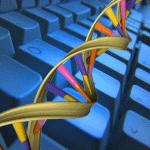Bioinformatics
|
28 february 2015 05:53:31 |
| The Spatial Chemical Langevin Equation and Reaction Diffusion Master Equations: moments and qualitative solutions (Theoretical Biology and Medical Modelling) |
|
Tweet Background:
It has been established that stochastic effects play an important role in spatio-temporal biochemical networks. A popular method of representing such stochastic systems is the Reaction Diffusion Master Equation (RDME). However, simulating sample paths from the RDME can be computationally expensive, particularly at large populations. Here we investigate an uncommon, but much faster alternative: the Spatial Chemical Langevin Equation (SCLE.)
Methods:
We investigate moment equations and correlation functions analytically, then we compare sample paths and moments of the SCLE to the RDME and associated deterministic solutions. Sample paths are generated computationally by the Next Subvolume method (RDME) and the Euler-Maruyama method (SCLE), while a deterministic solution is obtained with an Euler method. We consider the Gray-Scott model, a well-known pattern generating system, and a predator–prey system with spatially inhomogeneous parameters as sample applications.
Results:
For linear reaction networks, it is well known that the first order moments of all three approaches match, that the RDME and SCLE match to the second moment, and that all approaches diverge at third order moments. For non-linear reaction networks, differential equations governing moments do not form a closed system, but a general moment equation can be compared term wise. All approaches match at the leading order, and the RDME and SCLE match at the second leading order. As expected, the SCLE captures many dynamics of the RDME where deterministic methods fail to represent them. However, areas of the parameter space in the Gray-Scott model exist where either the SCLE and RDME give qualitatively different predictions, or the RDME predicts patterns, while the SCLE does not.
Conclusions:
The SCLE provides a fast alternative to existing methods for simulation of spatial stochastic biochemical networks, capturing many aspects of dynamics represented by the RDME. This becomes very useful in search of quantitative parameters yielding desired qualitative solutions. However, there exist parameter sets where both the qualitative and quantitative behaviour of the SCLE can differ when compared to the RDME, so care should be taken in its use for applications demanding greater accuracy. |
| 182 viewsCategory: Bioinformatics |
 GeneDig: a web application for accessing genomic and bioinformatics knowledge (BMC Bioinformatics) GeneDig: a web application for accessing genomic and bioinformatics knowledge (BMC Bioinformatics)Cyclin and DNA Distributed Cell Cycle Model for GS-NS0 Cells (PLoS Computational Biology) 
|
| blog comments powered by Disqus |
MyJournals.org
The latest issues of all your favorite science journals on one page
The latest issues of all your favorite science journals on one page



